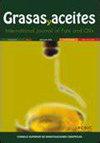突尼斯水域两种寄生性桡足类白柱足和lusnaeocera及其各自宿主鱼沙丁鱼和Merluccius的脂类和脂肪酸组成
IF 1.1
4区 农林科学
Q4 CHEMISTRY, APPLIED
引用次数: 1
摘要
本研究调查了两种寄生桡足类Lernaeocera lusci和Peroderma cylindrium及其各自鱼类宿主Merlucius Merluccius和Sardina pilchardus的详细脂质类别及其脂肪酸(FA)组成。通过薄层色谱法分离脂质类别,包括磷脂酰胆碱(PC)、磷脂酰乙醇胺(PE)、磷脂酰基丝氨酸(PS)、磷脂醇(PI)、三酰甘油(TAG)、蜡酯/胆固醇酯(WE/CE)、单二酰甘油(MDG)和游离脂肪酸(FFA)。结果表明,TAG和PC是寄生虫体内主要的脂质类别;而WE/CE和PS在宿主中含量最高。就FA组成而言,反复发现C16:0、C18:0、C18:1n-9、C20:5n-3和C22:6n-3在所研究的不同生物体的所有脂质类别中占主导地位。然而,在几种FA的丰度和分布方面观察到了一些差异。总的来说,所获得的结果强调,尽管寄生虫与其各自的宿主之间有着非常强的营养联系,但寄生虫可以通过特定的脂质图谱来区分。本文章由计算机程序翻译,如有差异,请以英文原文为准。
Lipid classes and fatty acid composition in two parasitic copepods Peroderma cylindricum and Lernaeocera lusci and their respective fish hosts Sardina pilchardus and Merluccius merluccius from the Tunisian waters
The present study investigates the detailed lipid classes and their fatty acid (FA) compositions from two parasitic copepods Lernaeocera lusci and Peroderma cylindricum and their respective fish host species Merluccius merluccius and Sardina pilchardus. The lipid classes, including phosphatidylcholine (PC), phosphatidylethanolamine (PE), phosphatidylserine (PS), phosphatidylinositol (PI), triacylglycerol (TAG), wax ester/cholesterol ester (WE/CE), mono-diacylglycerol (MDG), and free fatty acids (FFA) were separated by thin layer chromatography. The results revealed that TAG and PC were the major lipid classes in parasites; while WE/CE and PS were the most abundant in hosts. As for FA composition, C16:0, C18:0, C18:1n-9, C20:5n-3, and C22:6n-3 were recurrently found to be dominant in all lipid classes of the different organisms studied. However, some differences concerning the abundance and the distribution of several FAs were observed. Overall, the obtained results highlighted that despite the quite strong trophic connection between the parasites and their respective hosts, the parasites could be distinguished by specific lipid profiles.
求助全文
通过发布文献求助,成功后即可免费获取论文全文。
去求助
来源期刊

Grasas y Aceites
工程技术-食品科技
CiteScore
2.50
自引率
0.00%
发文量
50
审稿时长
3 months
期刊介绍:
Grasas y Aceites is a peer-reviewed journal devoted to the publication of original articles concerning the broad field of lipids, especially edible fats and oils from different origins, including non acyl lipids from microbial origin relevant to the food industry. It publishes full research articles, research notes, reviews as well as information on references, patents, and books.
Grasas y Aceites publishes original articles on basic or practical research, as well as review articles on lipid related topics in food science and technology, biology, (bio)chemistry, medical science, nutrition, (bio)technology, processing and engineering. Topics at the interface of basic research and applications are encouraged. Manuscripts related to by-products from the oil industry and the handling and treatment of the wastewaters are also welcomed.
Topics of special interest to Grasas y Aceites are:
-Lipid analysis, including sensory analysis
-Oleochemistry, including lipase modified lipids
-Biochemistry and molecular biology of lipids, including genetically modified oil crops and micro-organisms
-Lipids in health and disease, including functional foods and clinical studies
-Technical aspects of oil extraction and refining
-Processing and storage of oleaginous fruit, especially olive pickling
-Agricultural practices in oil crops, when affecting oil yield or quality
 求助内容:
求助内容: 应助结果提醒方式:
应助结果提醒方式:


